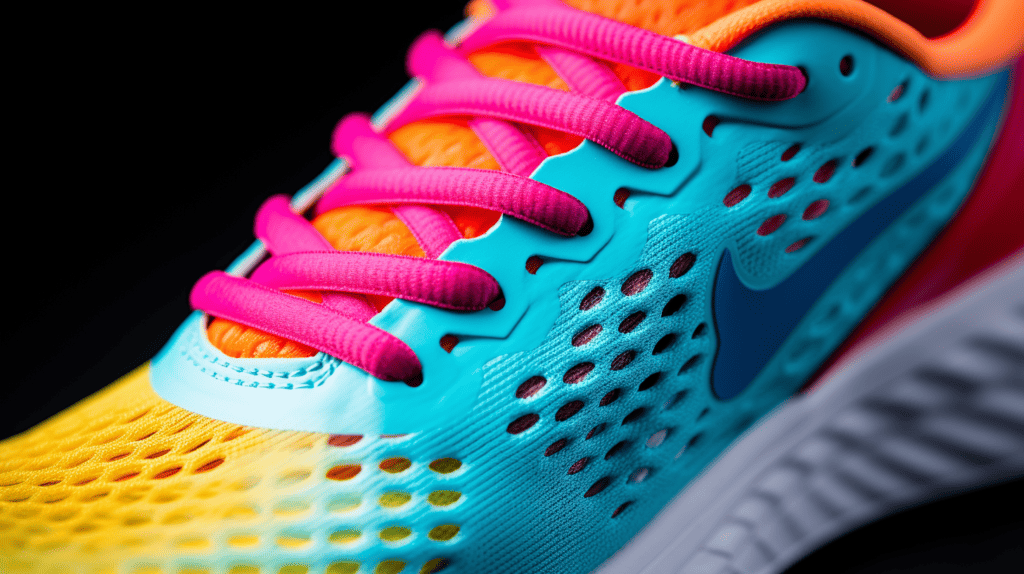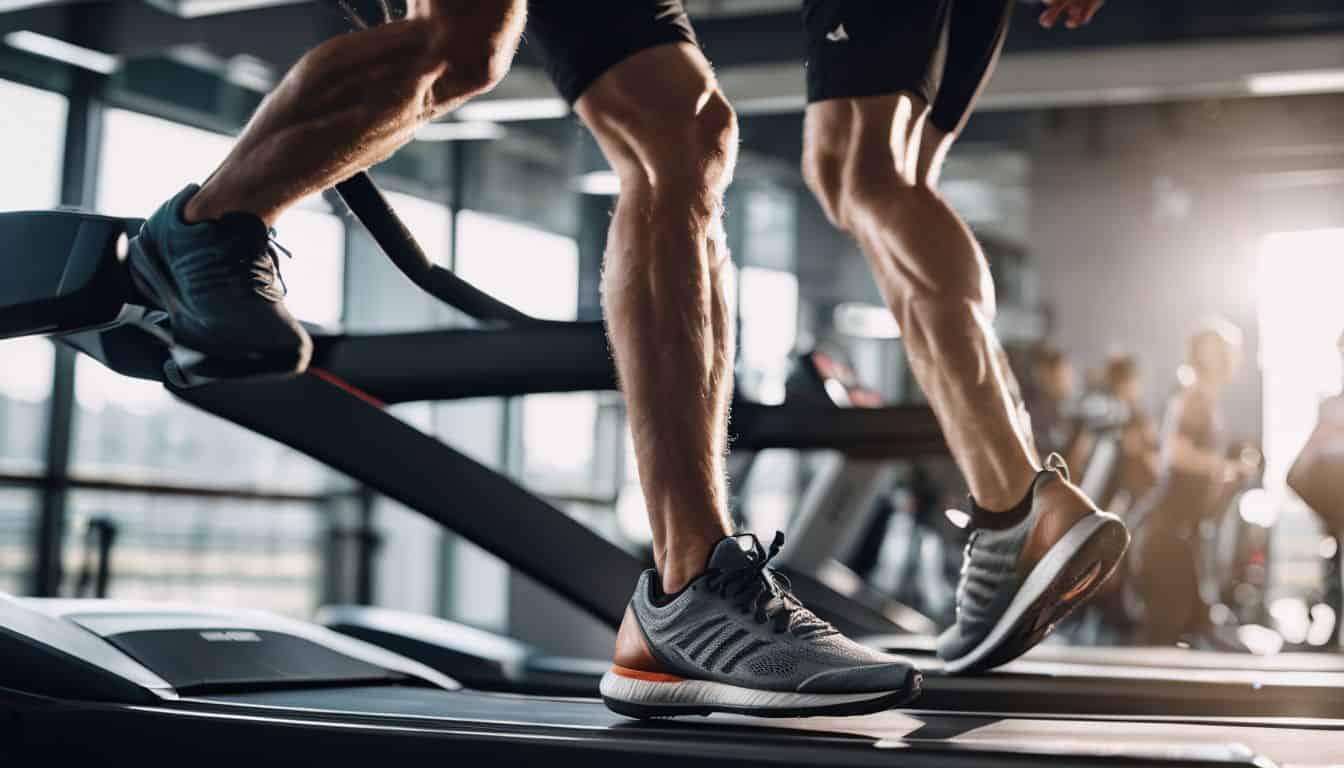Ever found yourself pondering if your workout kicks are just right for those treadmill runs? Yep, it’s a question that has tripped up the best of us. So, after diving deep into research and factoring in the unique needs of various sports activities, I’ve curated this blog post to clear up all your doubts.
It’s time to dispel any uncertainties – let’s dive into everything you need to know!
Key Takeaways
- Training shoes are not ideal for running on a treadmill due to potential impacts on performance, risk of injury, lack of comfort and support, and insufficient traction.
- Running shoes provide better cushioning, support, and traction specifically designed for the impact and movements of running.
- When choosing shoes for treadmill running, consider factors such as cushioning, lightweight design, proper fit, support, shock absorption, stability, breathability,and flexibility.
- It is important to prioritize finding running shoes that fit well and feel comfortable to enhance your performance and reduce the risk of injury during treadmill workouts.
The Difference Between Training Shoes and Running Shoes
Training shoes and running shoes don’t look the same. They have different designs for good reasons. Training shoes give you grip. This is so you won’t slip when doing workouts like CrossFit or weight lifting.
But they also keep your feet from moving side to side too much.
Running shoes are not the same as training shoes. They flex more because this helps when you run long distances. There’s special cushioning in running shoes right under the middle of your foot as well.
This takes care of your feet by taking some pressure off them while you run, making each step less hard on your body.
Can Training Shoes Be Used for Running on a Treadmill?
Training shoes may not be ideal for running on a treadmill due to potential impacts on performance, the risk of injury, comfort and support, and traction on the treadmill surface.
Impact on performance
Running in training shoes might slow you down. Every shoe has a weight, and the heavier it is, the harder your feet have to work. If we add 100 grams to each shoe, this can make running tougher.
That’s because more energy goes into lifting your feet than going forward.
In contrast, light and cushy running shoes can make a difference for good speed on a treadmill. It helps use less oxygen as you run! These shoes give ease of running without losing breath too quickly.
This means better exercises with less struggle!
Potential risk of injury
Running in training shoes can hurt you. They are not made for running. Most times, they don’t have enough cushion to take in the shock from your feet hitting the treadmill. That’s why your feet may ache if you run in them.
Running barefoot on a treadmill is also risky. It can strain your joints as there is no padding to soften the blow of each step. Heavier runners are more likely to get hurt this way too because their bodies need more protection against high impacts when they run.
Comfort and support
When it comes to comfort and support, choosing the right shoes for running on a treadmill is crucial. Cushioning is important as it helps absorb impact and keeps you comfortable while running.
Look for shoes with good padding, shock resistance, and arch support. Shoes with proper sole cushioning and pronation control can also provide stability and prevent injuries. Flexibility is another factor to consider as it allows your feet to move naturally while running.
Remember that finding the right fit is essential for maximum comfort and support during your treadmill runs.
Traction on treadmill surface
When running on a treadmill, the traction of your shoes on the surface is an important consideration. You want to make sure that you have enough grip to prevent slipping or sliding during your workout.
However, the traction needed for treadmill running is not as aggressive as what you might need for outdoor running or other sports activities. This is because treadmills have a smooth and consistent surface that doesn’t require deep treads or lugs on your shoes.
So, when choosing shoes for treadmill running, look for ones that provide adequate traction without being overly aggressive.
Personal Experiences: Training Shoes vs Running Shoes on Treadmill
I’ve had personal experiences using both training shoes and running shoes on the treadmill, and I can tell you that there is a noticeable difference. When I wore training shoes, which are designed for multi-directional movements like strength training or CrossFit, I found that they didn’t provide as much cushioning and support as my running shoes.
This made my feet feel more fatigued during longer treadmill sessions. On the other hand, when I switched to running shoes specifically designed for running on pavement or treadmills, I immediately felt a difference in comfort and impact absorption.
The extra cushioning in the midsole of the running shoes helped to reduce any discomfort or pain in my feet while pounding away on the treadmill. The traction of my running shoes was also better suited for the smooth surface of the treadmill compared to the sole pattern of my training shoes.
Overall, based on my personal experiences, I highly recommend using dedicated running shoes for your treadmill workouts if you want maximum comfort and performance.
Choosing the Right Shoes for Treadmill Running
When choosing shoes for treadmill running, it is important to consider factors such as cushioning, lightweight design, and proper fit.
Considerations for treadmill running
When running on a treadmill, there are some important things to consider to ensure a good workout:
- Cushioning: Look for shoes with adequate cushioning to absorb the impact of running on a treadmill and protect your joints.
- Support: Make sure the shoes provide enough support to maintain your proper stance and reduce the risk of injuries.
- Soreness prevention: Choose shoes that help prevent soreness by providing proper shock absorption and cushioning.
- Foundation: The right shoes can provide a stable foundation for your entire body during treadmill running, helping you maintain balance and form.
- Injuries: Selecting shoes designed specifically for running can help minimize the risk of common treadmill-related injuries, such as shin splints or ankle sprains.
Features to look for in treadmill running shoes
When choosing treadmill running shoes, there are important features to consider. Here are some key things to look for:
- Cushioning: Make sure the shoes have adequate padding to absorb impact and provide comfort during your treadmill runs.
- Support: Look for shoes that offer good support, especially around the arches and heels. This can help prevent injuries and maintain proper alignment while running.
- Shock absorption: Shoes with good shock absorption can reduce the strain on your joints, which is important when running on a treadmill that has a harder surface compared to outdoor terrain.
- Comfort: Choose shoes that fit well and feel comfortable on your feet. This will ensure a pleasant running experience and minimize any discomfort or pain during your workouts.
- Stability: Treadmill running shoes should provide stability and prevent excessive side-to-side movement, keeping you balanced and reducing the risk of ankle sprains.
- Breathability: Look for shoes with breathable materials to keep your feet cool and dry, even during intense treadmill workouts.
- Lightweight: Lighter shoes can make it easier to move quickly on the treadmill and reduce fatigue during longer runs.
- Durability: Consider the durability of the shoes, especially if you plan to use them frequently for treadmill running. A durable pair of shoes will last longer and provide better value for your money.
- Flexibility: Opt for shoes that offer enough flexibility in the sole, allowing your foot to move naturally as you run on a treadmill.
- Arch support: If you have high or low arches, choose shoes with appropriate arch support to maintain proper foot alignment and prevent discomfort or injury.

Importance of proper fit
Choosing the right size and fit for your running shoes is incredibly important when it comes to treadmill workouts. Properly fitted footwear not only helps prevent injuries but also protects against overuse and provides stability on the treadmill surface.
It ensures that you have a comfortable fit and supports your individual needs for a safe and effective workout. Gait analysis can be helpful in determining the perfect pair of running shoes that cater to your specific requirements.
So, make sure you prioritize finding running shoes that fit well, feel comfortable, and provide the support you need for a successful treadmill session.
Conclusion on Can Training Shoes Be Used For Running On Treadmill
In conclusion, while you can technically use training shoes for running on a treadmill, it is not the best choice. Running shoes are designed specifically for the impact and movements of running, providing better support, cushioning, and traction.
Investing in a good pair of running shoes will enhance your comfort and performance on the treadmill, reducing the risk of injury. So lace up those proper running shoes and enjoy your runs on the treadmill!
FAQs on Can Training Shoes Be Used For Running On Treadmill
1. Can I use training shoes for running on a treadmill?
Yes, you can use training shoes for running on a treadmill as they provide cushioning and support needed for indoor running.
2. Are there any specific features in training shoes that are ideal for treadmill running?
Training shoes with good shock absorption, cushioning, and stability are ideal for treadmill running to reduce the impact on your joints.
3. What is the difference between training shoes and running shoes?
Training shoes are designed to provide all-around support and stability for various types of workouts, while running shoes are specifically designed to enhance performance during outdoor runs.
4. Can wearing training shoes on a treadmill affect my performance or cause injuries?
Wearing proper training shoes should not negatively impact your performance or cause injuries when used on a treadmill. However, it’s important to ensure that your footwear fits well and provides adequate support.
5. Should I consider buying dedicated running shoes if I primarily run on a treadmill?
While using suitable training shoes is generally sufficient for indoor treadmill running, runners who frequently train or participate in races might benefit from investing in specialized running footwear tailored to their individual needs and preferences.





Leave a Reply